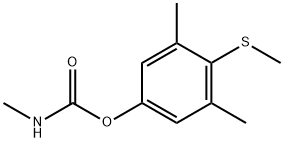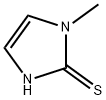MethiocarbSolutioninMethanol , 1000 μg/mlinmethanol, uncertainty: 2% , 2032-65-7
Synonym(s):
Mercaptodimethur
CAS NO.:2032-65-7
Empirical Formula: C11H15NO2S
Molecular Weight: 225.31
MDL number: MFCD00055450
EINECS: 217-991-2
| Pack Size | Price | Stock | Quantity |
| 1.2ml | RMB239.20 | In Stock |
|
| others | Enquire |
PRODUCT Properties
| Melting point: | 119°C |
| Density | 1.1838 (rough estimate) |
| vapor pressure | 1.5 x 10-5 Pa (20 °C) |
| refractive index | 1.4790 (estimate) |
| storage temp. | 0-6°C |
| solubility | DMF: 20 mg/ml,DMSO: 20 mg/ml,DMSO:PBS (pH 7.2) (1:1): 0.5 mg/ml,Ethanol: 10 mg/ml |
| Boiling point: | 310.7±42.0 °C(Predicted) |
| pka | 12.16±0.46(Predicted) |
| form | Crystalline Solid |
| color | White |
| Water Solubility | Insoluble |
| BRN | 1881431 |
| Stability: | Light Sensitive |
| CAS DataBase Reference | 2032-65-7(CAS DataBase Reference) |
| NIST Chemistry Reference | 4-Methylthio-3,5-xylyl methylcarbamate(2032-65-7) |
| EPA Substance Registry System | Methiocarb (2032-65-7) |
Description and Uses
Methiocarb was originally developed by Bayer as an
insecticide. The bird-repellent properties of the compound
were quickly recognized, however, and a number of
applications for bird damage management followed (42).
Methiocarb is a secondary repellent, and repellency
occurs through aversive conditioning, by which birds
that feed on treated food become sick and associate
either the food or characteristics of the food with the
discomfort (21). As a result, affected birds learn to avoid
that food item. Often the avoidance response is locationdependent.
For example, common ravens (Corvus corax)
that learn not to eat eggs at one site will still feed on
eggs at a different location (43).
Methiocarb is an insecticide, molluscicide and acaricide with contact and stomach action. It is used to control slugs, snails and insects in a wide range of crops. Soil insects are controlled. Methiocarb is also used as a seed-treatment and bird repellent.
Safety
| Symbol(GHS) |   GHS06,GHS09 |
| Signal word | Danger |
| Hazard statements | H300-H410 |
| Precautionary statements | P264-P270-P273-P301+P310-P391-P405 |
| Hazard Codes | T;N,N,T |
| Risk Statements | 25-50/53 |
| Safety Statements | 22-37-45-60-61 |
| RIDADR | UN 2811/2757 |
| WGK Germany | 3 |
| RTECS | FC5775000 |
| HazardClass | 6.1(a) |
| PackingGroup | II |
| Hazardous Substances Data | 2032-65-7(Hazardous Substances Data) |
| Toxicity | LD50 in male, female rats (mg/kg): 70, 60 orally (Gaines) |




